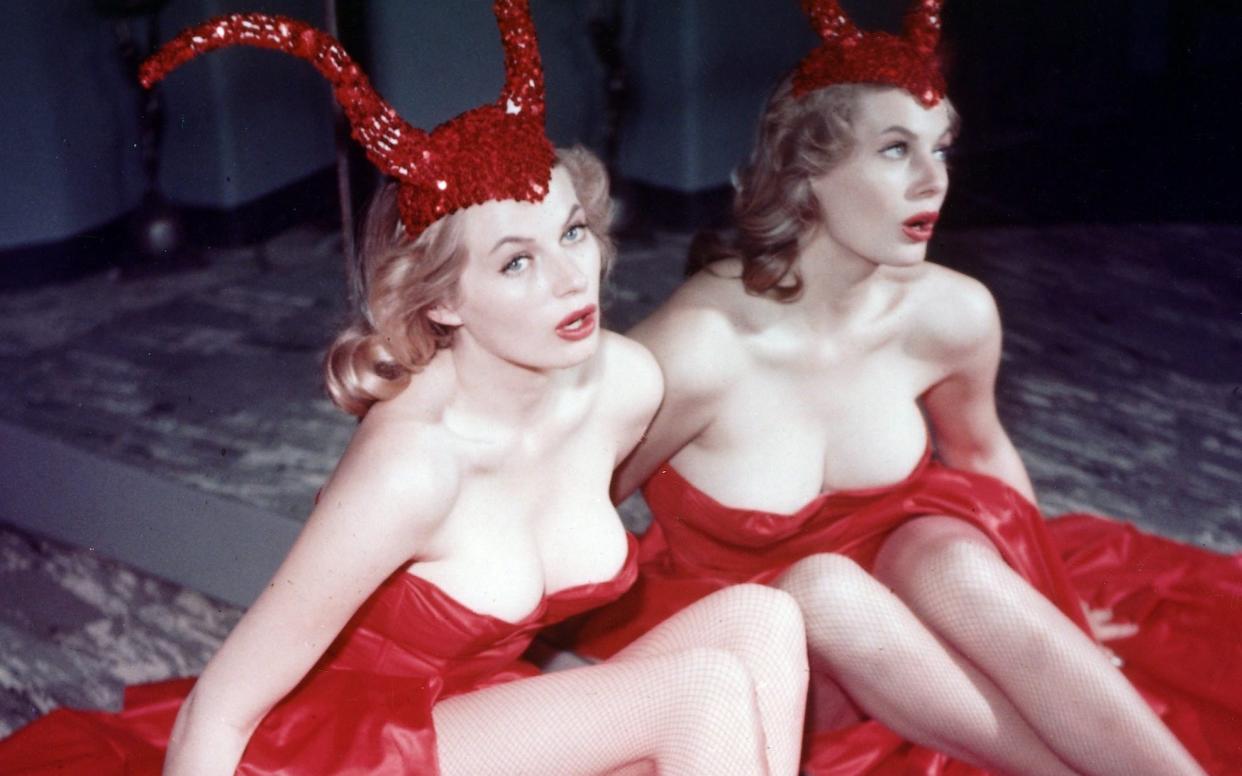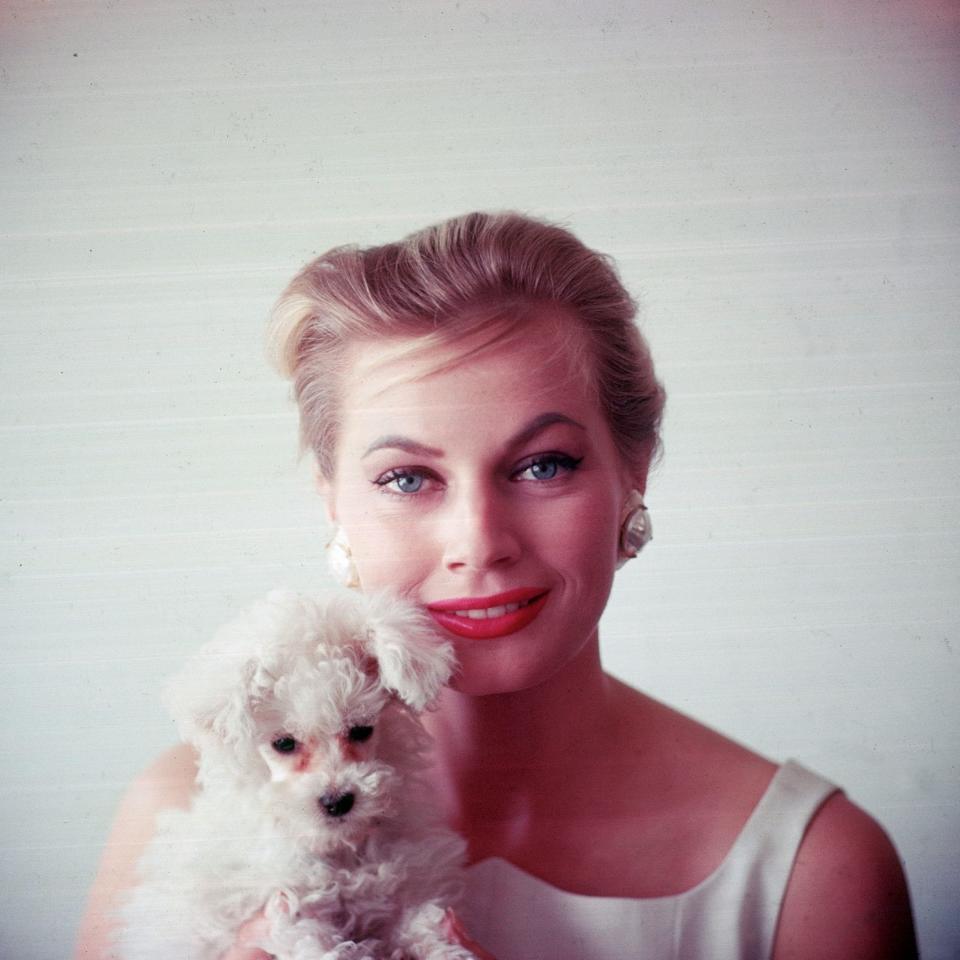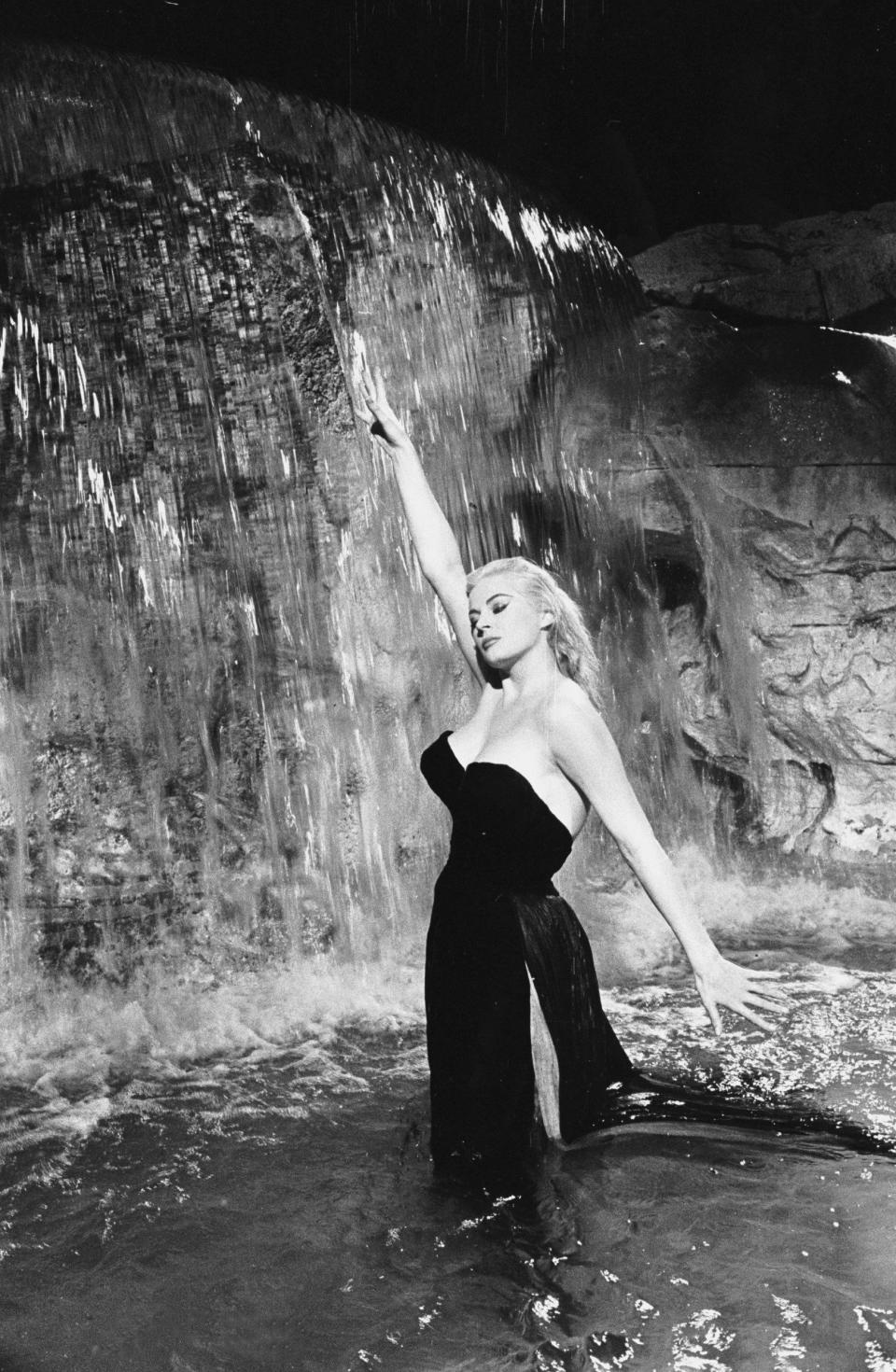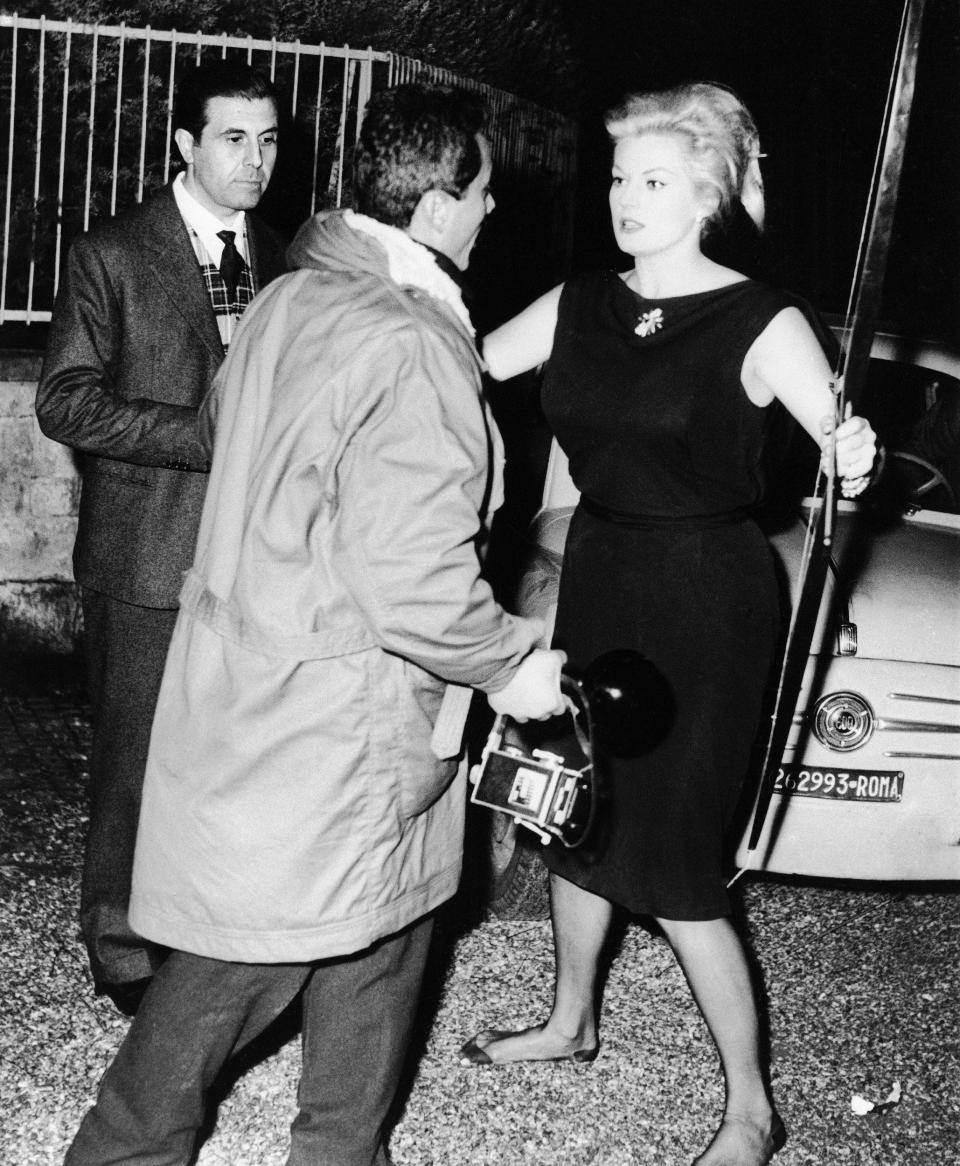The bitter life of Anita Ekberg who scandalised the world and scared the Pope

When Federico Fellini met the Swedish actress Anita Ekberg in 1959 by the Spanish Steps in Rome, he had “that sense of the marvellous, of a hypnotic stupor, of the disbelief one feels confronting exceptional creatures like a giraffe, the elephant, the baobab tree”. He didn’t stop there, comparing her variously to “a powerful panther playing the mischievous young girl”, “a lioness proud of her good health” and “a shark emanating the heat of a summer day”. It was as if her sexiness went beyond what was plausible for a human, and belonged rather to Nature. With her, Fellini apprehended for the first time “the platonic reality of things”. “So,” he said to himself, “These are the earlobes, these are the gums, this is human skin...”
“She was a horse!” chimed in Fellini’s friend, Tullio Kezich, in his set diary of La Dolce Vita. It was a chilly March night when they filmed the famous frolic in the Trevi fountain, but Ekberg, said Kezich, “plunged into that cold fountain without hesitation or fuss. She was so Swedish and healthy.” No animals for her jealous co-star Marcello Mastroianni, who had drunk so much fortifying vodka that he was barely able to stand up in the fountain – he said Ekberg reminded him of a Wehrmacht stormtrooper.
The Nazis would have been delighted with the way 1950s Hollywood billed the über-Aryan Ekberg as “the volcanic Valkyrie”. Born in 1931, the sixth of the Malmö harbourmaster’s eight children, she left school to become a model (to her strict Protestant parents’ distress) and was crowned Miss Sweden in 1950. The prize was two frocks and a trip to Atlantic City for the Miss America pageant.
Ekberg didn’t speak a word of English, but was taught to trout pout by the modelling agent Eileen Ford – “All the good models look like fish today,” Ford advised – and got a starlet contract at Universal, who offered her lessons in elocution, drama, dancing and riding; she declined all but the last.
Howard Hughes, with whom she was having an affair, wanted to change her nose, teeth and name; she refused that too. With her first pay cheque, she bought a mink stole (“I was tremendously spoiled”) and whizzed around Hollywood in a white Jaguar “laughing at bad jokes”. She made enemies of the press, who called her Anita Iceberg, and of a stripper called Evelyn “Treasure Chest” West, who pelted her with tomatoes during her own nightclub act because she thought Ekberg had sneered at her bosom.

One thing she didn’t do much was work: “People think I’m just a playgirl.” Blaming the immigration authorities, she didn’t appear in a film until 1953, when she popped up as a Venusian guard in Abbott and Costello Go to Mars. Bizarrely, for her first credited role, in Blood Alley (1955), she was cast as a Chinese.
Soon the bombshell parts came in – she left Universal to become “Paramount’s Marilyn” after standing in for Monroe on the 1954 Christmas USO tour with Bob Hope, who called her “the greatest thing to come out of Sweden since the smorgasbord” – but her big break was a 1955 Time exposé of “Sin and Sweden”, which seized on Ekberg as a symbol of the new, liberated Scandinavian sexual ethos.
Sweden was a problem for Red Scare America: a country that had embraced socialist concepts, and was actually doing rather well. Eisenhower articulated the counter-argument in 1960 when he claimed Sweden’s welfare policies led to sin, nudity, drunkeness and suicide. (In fact, the suicide rate was high across Scandinavia and more to do with lack of sunlight.) Ekberg, now a repository of political as well as sexual fantasies, embraced the role: “You Americans have a darn complex about sex.”

Could she act? In her opinion, “everyone with common sense can”. She won a Golden Globe as Helene opposite Henry Fonda in War and Peace (1956), and her innate charisma translates into a ferocious watchability. Her range was limited, but arguably never tested. It took Fellini to coax the performance of a lifetime out of her, and it is no coincidence that, in La Dolce Vita, she played herself.
A financial crisis in the late 1950s forced many productions to decamp to Rome’s Cinecittà, aka “Hollywood on the Tiber”, where wages were lower. When Ekberg arrived in 1958, the press said the number of hills in Rome had increased from seven to nine. The Pope called her a “danger to traffic”. Some say it was Ekberg who then courted Fellini, driving in ostentatious circles around his film studio until he spotted her. In fact, he had already fallen in love with her photograph, and wanted to build his frieze of Roman life around her.
“When you visit Italy,” said Fran Lebowitz, “you realise that Fellini made documentaries.” From his “office” at the Canova bar, he jotted down what he saw into vignettes for the film. Ekberg was appalled to hear there wasn’t a script – “I told you this was a joke. This man isn’t a director, he’s a madman!” – even more so when Fellini suggested she could write a script if she really wanted one.
All the material he needed was being provided in real time by Ekberg and her alcoholic husband Anthony Steele, a British matinée idol of finite talent, whom she had married in Florence in 1956 in a gown that left one shoulder scandalously bare (“more Tarzan than Jane,” said the papers). On their wedding night, she slammed the door in his insensate face at 3am. Two days later, she found him “swinging from the lights like an ape”. His chief pursuits were collecting swizzle sticks from bars and being photographed, drunk, on all fours.
Miraculously, in 1959 they were still married, but their punch-ups were public – to the delight of the Via Veneto “action photographers” (soon to be renamed “paparazzi”, after Paparazzo in La Dolce Vita). In the film, Steele is the alcoholic Robert (played by former Tarzan Lex Barker), who slaps Sylvia (Ekberg) after she has been out all night with Marcello. The Trevi scene came from Ekberg bathing a cut there one night after dancing barefoot in a nightclub.
Fellini got the best out of Ekberg, flirting outrageously, although she despised his nickname “Anitona” (“Great Big Anita”). She thought him “wonderful… a great liar and very vain”. Obsessed with women’s clothes, he dressed her outrageously, making her climb St Peter’s in a riff on a cardinal’s robes. “I think you are making a fool out of me!” she said.

Characters and incidents emerged to fill out Fellini's “vast fresco”, which was an instant classic – and a succès de scandale. The Roman bluebloods said they had been duped into appearing in what the Vatican newspaper called “The Disgusting Life”: “a travesty that allowed hundreds of Roman whores, faggots, screen queens, press agents, artists, aristocrats and lawyers to play revolting caricatures of themselves”. In Britain, it was the first time an actress had been debated in the House of Lords, with the poster accused of obscenity. (“Who is Anita Ekberg?” was the peers’ warm response.)
Settling in Italy for good, Ekberg tried to fix her “dolce vita” in aspic but instead she trapped herself in self-parody. She sped around Rome in a custom Ferrari, and attacked the paparazzi on her doorstep with a bow and arrow. Fellini didn’t help, fetishising her as a 40ft statue on whose breast the feverish doctor perches in Le Tentazioni del Dottor Antonio (1962). And despite her entanglements with stars of profound talent, like Gary Cooper, Yul Brynner – who taught her, it is said, the pleasure of the whip – and Frank Sinatra, whose hand she turned down, when it came to marriage this first-class beauty was addicted to third-class rotters.
In 1964, five years after she had left Steele (who hit her, and broke her dog’s legs), she married the ominously named Rik Van Nutter, a Hawaiian posing as an Austrian nobleman, a B-movie actor now barely remembered as Felix Leiter in Thunderball. Van Nutter mixed olive oil with red alcohol for his tan, and together they started a car rental business. After 12 years they divorced. “He emptied three bank accounts of mine. He stole my yacht, my outboard motorboat. He stole my villa and all the art objects and silver and furniture. I had a cargo ship going around Singapore. He stole that as well.”

In misery, her weight ballooned to 14 stone. As the ungallant Van Nutter put it: “Now she looks like a beached whale.” By the mid-1970s she was doing a Munich cabaret act. From that low point, she clawed herself back, buying an ugly villa in the hills above Rome, with a view of the sea and holidaying popes as neighbours, and settled down to enjoy a long-running feud with Gina Lollobrigida. The public only realised she had literally gone to the dogs when her Great Dane knocked her over, and she was hospitalised, penniless, in 2011.
What went wrong for Anita Ekberg? “What sons of bitches I have met in my life,” she would say, but it was Gianni Agnelli, scion of Fiat and de facto Italian royalty, who really broke her heart. Even though he once posed her naked on his desk to scandalise his business friends after an all-nighter, their long affair was kept a secret from the press. He kept her afloat financially, but in true diva style she blew it all. “If he wasn’t dead, he would still be my ideal man,” she said at the end of her life.
By then, she noted, there were more blondes in Italy than in the whole of Scandinavia. “If you want “la dolce vita”, then it is how you look at life. I’ve just built a wonderful birdbath,” said the woman who once graced the Trevi fountain. She died in 2015, aged 83, to face the truth of her famous line: “I don’t know if paradise or hell exists, but I’m sure hell is more groovy.”


